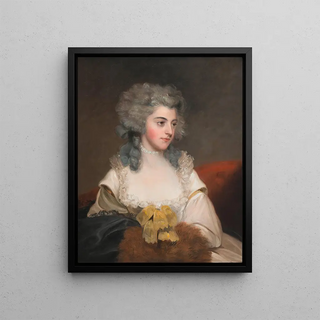Art print | Susannah Edith Lady Rowley - John Hoppner


View from behind

Frame (optional)
In the vast panorama of art history, some works manage to capture the very essence of humanity, transcending time and space. "Susannah Edith Lady Rowley" by John Hoppner is undoubtedly one of these creations. Painted at the end of the 18th century, this piece embodies both the beauty and the complexity of human emotions. Through Lady Rowley's penetrating gaze, the viewer is invited to explore a world where the delicacy of features and the depth of feelings meet. Hoppner, a master of portraiture, succeeds in immortalizing not only his model's appearance but also her character, grace, and aura.
Style and uniqueness of the work
Hoppner's style is distinguished by its realistic approach, blending refined technique with palpable emotional sensitivity. In "Susannah Edith Lady Rowley," the nuances of color and the finesse of details reveal impressive mastery. The drapes of Lady Rowley's dress seem almost alive, while shadows and lights create an intimate atmosphere. Hoppner manages to evoke a certain melancholy, a reflection on fleeting beauty, while celebrating the inner strength of his model. The composition, well balanced, draws the eye toward Lady Rowley's face, where each expression tells a story. This portrait is a true ode to femininity, where vulnerability and strength coexist harmoniously.
The artist and his influence
John Hoppner, born in 1758, established himself in the British art world as one of the leading portraitists of his time. His training with great masters and his meticulous observation of human nature allowed him to develop a unique style, combining realism and romanticism. Hoppner captured the spirit of the era, navigating between neoclassical influences and the beginnings of romanticism. His portraits, often imbued with a certain melancholy, marked his era and continue to inspire contemporary artists. By choosing to paint figures of high society, Hoppner also contributed to shaping the image of British aristocracy, leaving a lasting imprint.

Matte finish

View from behind

Frame (optional)
In the vast panorama of art history, some works manage to capture the very essence of humanity, transcending time and space. "Susannah Edith Lady Rowley" by John Hoppner is undoubtedly one of these creations. Painted at the end of the 18th century, this piece embodies both the beauty and the complexity of human emotions. Through Lady Rowley's penetrating gaze, the viewer is invited to explore a world where the delicacy of features and the depth of feelings meet. Hoppner, a master of portraiture, succeeds in immortalizing not only his model's appearance but also her character, grace, and aura.
Style and uniqueness of the work
Hoppner's style is distinguished by its realistic approach, blending refined technique with palpable emotional sensitivity. In "Susannah Edith Lady Rowley," the nuances of color and the finesse of details reveal impressive mastery. The drapes of Lady Rowley's dress seem almost alive, while shadows and lights create an intimate atmosphere. Hoppner manages to evoke a certain melancholy, a reflection on fleeting beauty, while celebrating the inner strength of his model. The composition, well balanced, draws the eye toward Lady Rowley's face, where each expression tells a story. This portrait is a true ode to femininity, where vulnerability and strength coexist harmoniously.
The artist and his influence
John Hoppner, born in 1758, established himself in the British art world as one of the leading portraitists of his time. His training with great masters and his meticulous observation of human nature allowed him to develop a unique style, combining realism and romanticism. Hoppner captured the spirit of the era, navigating between neoclassical influences and the beginnings of romanticism. His portraits, often imbued with a certain melancholy, marked his era and continue to inspire contemporary artists. By choosing to paint figures of high society, Hoppner also contributed to shaping the image of British aristocracy, leaving a lasting imprint.






